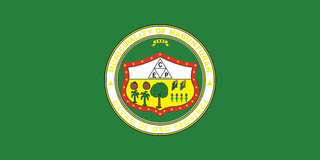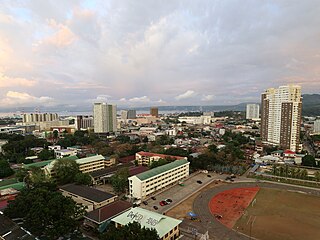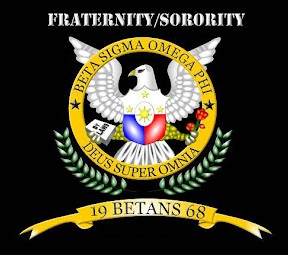
Davao del Norte, officially the Province of Davao del Norte, is a province in the Philippines located in the Davao Region in Mindanao. Its capital and largest city is Tagum. The province also includes Samal Island to the south in Davao Gulf.

Davao, officially the Province of Davao, was a province in the Philippines on the island of Mindanao. The old province is coterminous with the present-day Davao Region or Region XI. It was divided into three provinces of Davao del Norte, Davao Oriental, and Davao del Sur with the passage of Philippine Republic Act No. 4867 on May 8, 1967. Two more provinces, Compostela Valley and Davao Occidental, were carved out of the territories of Davao del Norte and Davao del Sur respectively. The descendant provinces were reorganized into the current region in 2001.

Davao Region, formerly called Southern Mindanao, is an administrative region in the Philippines, designated as Region XI. It is situated at the southeastern portion of Mindanao and comprises five provinces: Davao de Oro, Davao del Norte, Davao del Sur, Davao Oriental, and Davao Occidental.

Davao de Oro, officially the Province of Davao de Oro, is a province in the Philippines located in the Davao Region in Mindanao. Its capital is Nabunturan while Monkayo is the most populous. It used to be part of the province of Davao del Norte until it was made a separate province in 1998.

Compostela, officially the Municipality of Compostela, is a 1st class municipality in the province of Davao de Oro, Philippines. According to the 2020 census, it has a population of 89,884 people.

Laak, officially the Municipality of Laak, is a 1st class municipality in the province of Davao de Oro, Philippines. According to the 2020 census, it has a population of 79,744 people.

Mabini, officially the Municipality of Mabini, is a 2nd class municipality in the province of Davao de Oro, Philippines. According to the 2020 census, it had a population of 43,552.

Maragusan, officially the Municipality of Maragusan, is a 1st class municipality in the province of Davao de Oro, Philippines. According to the 2020 census, it has a population of 64,412 people.

Mawab, officially the Municipality of Mawab, is a 3rd class municipality in the province of Davao de Oro, Philippines. According to the 2020 census, it has a population of 39,631 people, making it the least populated municipality in the province.

Nabunturan, officially the Municipality of Nabunturan, is a 1st class municipality and capital of the province of Davao de Oro, Philippines. According to the 2020 census, it has a population of 84,340 people.
The legislative districts of Davao del Norte are the representation of the province of Davao del Norte in the various national legislatures of the Philippines. The province is currently represented in the lower house of the Congress of the Philippines through its first and second congressional districts.
The legislative districts of Davao de Oro are the representations of the province of Davao de Oro in the various national legislatures of the Philippines. The province is currently represented in the lower house of the Congress of the Philippines through its first and second congressional districts.
The legislative district of Davao was the representation of the historical province of Davao in the various national legislatures of the Philippines until its dissolution in 1967.

Central Mindanao University is a research state university located in the heart of Mindanao Island, province of Bukidnon, Philippines. Founded in 1910, it is one of the oldest premier universities in the southern Philippines. CMU is recognized by the Commission on Higher Education (Philippines) as the Center of Excellence in the field of Agriculture, Forestry, Veterinary Medicine and Biology; and Center of Development in Mathematics, Environmental Science and Teacher Education. In 2017, CMU became the first higher education institution in Mindanao to be awarded with Institutional Accreditation by the Accrediting Agency of Chartered Colleges and Universities in the Philippines.

Cagayan de Oro (CDO), officially the City of Cagayan de Oro, is a 1st class highly urbanized city in the region of Northern Mindanao, Philippines. According to the 2020 census, it has a population of 728,402 people, making it the 10th most populous city in the Philippines and the most populous in Northern Mindanao.

The University of Mindanao Broadcasting Network (UMBN) is a Philippine radio network majority-owned and controlled by the Torres family. It serves as the media arm of the University of Mindanao. Its headquarters are located at the UMBN Media Center, C. Bangoy St. cor. Palma Gil St., Poblacion, Davao City, while its national marketing offices are located in Makati. UMBN and its subsidiary Mt. Apo Broadcasting System run AM and FM stations in Mindanao, while its other subsidiary Ditan Communications runs the Visayas stations. It has three radio network brands, namely UMBN News & Public Affairs, Wild FM and Retro.

Beta Sigma Omega Phi is a service fraternity and sorority founded at University of Bohol on October 10, 1968. This was organized by Frank Paz Jr., Frederick Loor, and Remy Galbizo. Their aims were to foster lifetime brotherhood and sisterhood and to build noble leaders and better citizens. Members are encouraged to promote the welfare of students and to work for better and greater involvement in the affairs of the school as well as in the community. The organization facilitates a variety of community civic involvement, and services like tree planting, feeding programs, bloodletting, operation tuli, and lately the Brigada Eskwela. Betans 1968 have established 72 collegiate chapters throughout Philippines; most of these are on the island of Mindanao.

On December 7, 2019, a plebiscite was held in the province of Compostela Valley, Philippines, to determine if its residents approved renaming their province to Davao de Oro.

Davao de Oro's 1st congressional district is a congressional district for the House of Representatives of the Philippines in the province of Davao de Oro. It was created ahead of the 1998 Philippine House of Representatives elections by the same republic act of July 19, 1997 that established the province initially named Compostela Valley. The district encompasses most of the area of its namesake valley in the Mindanao Pacific Cordillera which were formerly within Davao del Norte's 1st district. It currently comprises the municipalities of Compostela, Maragusan, Monkayo, Montevista and New Bataan. It is currently represented in the 19th Congress by Maricar Zamora of the Lakas–CMD.

Davao de Oro's 2nd congressional district is a congressional district for the House of Representatives of the Philippines in the province of Davao de Oro. It was created ahead of the 1998 Philippine House of Representatives elections by the same republic act of July 19, 1997 that established the province initially named Compostela Valley. The district encompasses two noncontiguous areas of Davao de Oro: Laak in the Davao–Agusan Trough and the valley and coastal municipalities adjoining the provincial capital of Nabunturan, namely Mabini, Maco, Mawab and Pantukan. Much of these areas were previously within Davao del Norte's 2nd district. Ruwel Peter S. Gonzaga of the PDP–Laban currently serves as this district's representative in the 19th Congress, the first under the province's new name of Davao de Oro.

















